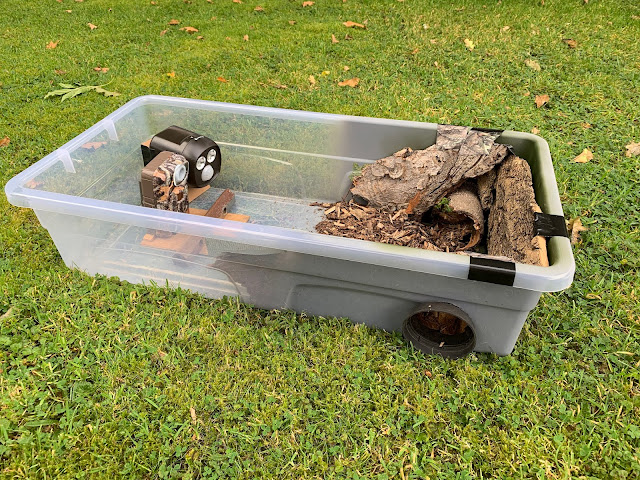Ever since the weasel turned up in the garden in the summer I have been trying to get another picture. Inspired by the Mostela*, a trail camera box used for monitoring stoat and weasel populations, I built one similar from a translucent plastic storage box (£7 from Dunelm). There are two holes at one end and a trail camera at the other. The Mostela was designed by Jeroen Mos, an ecologist and small mustelid researcher in The Netherlands, and is an enclosed box with a cutaway plastic pipe connecting the two entrance holes. Wanting better pictures in a more natural setting, I made mine to admit natural light and built a small "stage set" of bark and loose bark chippings at one end. The trail camera has a +2 dioptre lens to cope with the close focus. It can record in colour in daylight but reverts to infrared when the light is poor or at night and it is then augmented by a motion-activated battery-powered infrared security light (a Brlnno APL200). This is a view of the box with the lid removed.
Here is the box in the garden with two Victorian land drain pipes as access tunnels.
Like other small mustelids, weasels are very inquisitive animals and will investigate any small hole which might contain prey. For the first few days I baited the camera box with sunflower seeds so that it would smell of voles and mice but recently it has been left as it is (although mice and voles still visit every day). I had the camera box set in my garden and the local nature reserve for four weeks before a weasel eventually made a brief appearance this week. In fact it was very brief so I have added a 25% slow motion replay to the video.
Several other animals are much more regular visitors. They include wood mice, always at night and so in black and white. Wood mice visit every night and spend a lot of time in the box. There is no food for them but perhaps it is warm and dry and feels safe.
And a couple of very unexpected visitors. Both birds were in the box for over two minutes and got rather agitated when they couldn't find the way out.
I plan to leave my weasel box set in the hope of more recordings and, perhaps, one day even a visit from a stoat.
* Mos J, Hofmeester TG. The Mostela: an adjusted camera trapping device as a promising non-invasive tool to study and monitor small mustelids. Mamm Res. 65, 843-853 (2020). https://doi.org/10.1007/s13364-020-00513-y










No comments:
Post a Comment